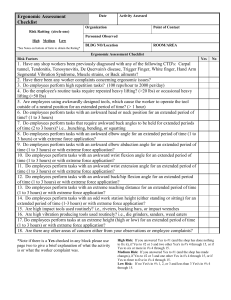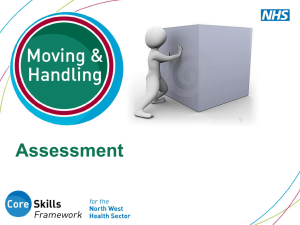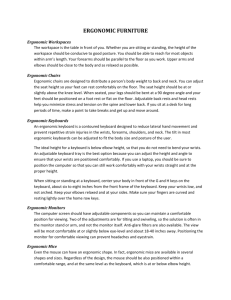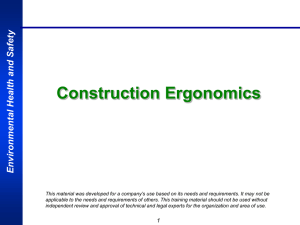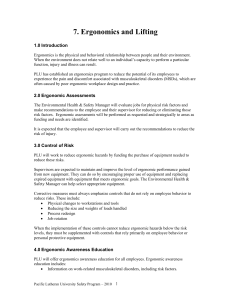Example of Ergonomic risk assessment
advertisement
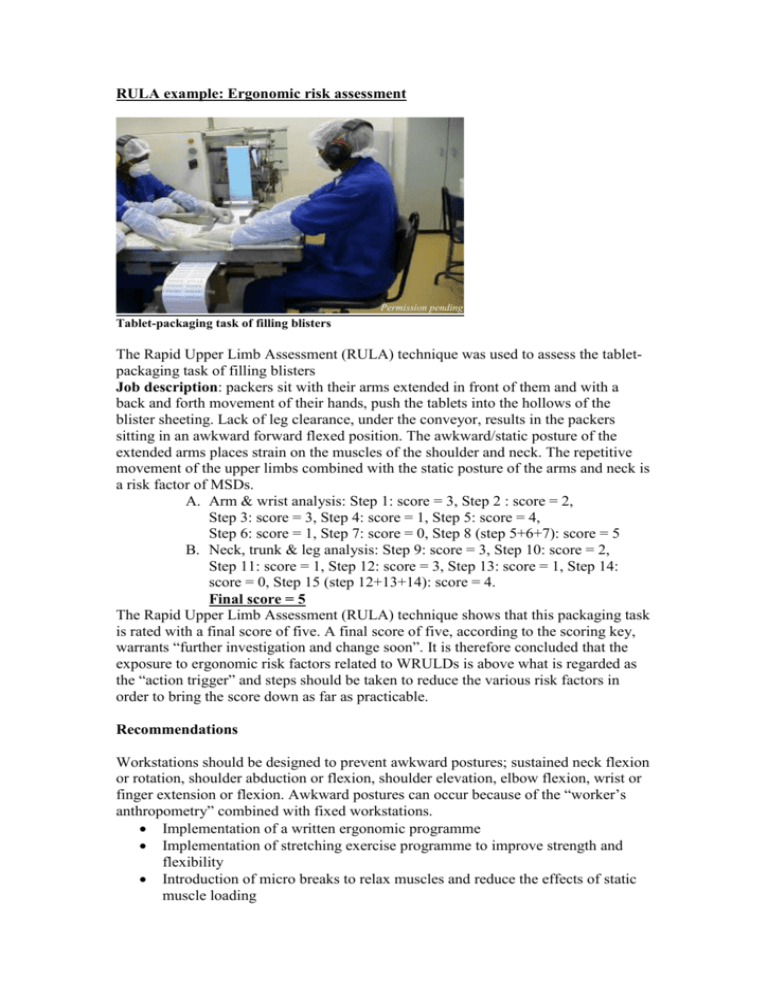
RULA example: Ergonomic risk assessment Permission pending Tablet-packaging task of filling blisters The Rapid Upper Limb Assessment (RULA) technique was used to assess the tabletpackaging task of filling blisters Job description: packers sit with their arms extended in front of them and with a back and forth movement of their hands, push the tablets into the hollows of the blister sheeting. Lack of leg clearance, under the conveyor, results in the packers sitting in an awkward forward flexed position. The awkward/static posture of the extended arms places strain on the muscles of the shoulder and neck. The repetitive movement of the upper limbs combined with the static posture of the arms and neck is a risk factor of MSDs. A. Arm & wrist analysis: Step 1: score = 3, Step 2 : score = 2, Step 3: score = 3, Step 4: score = 1, Step 5: score = 4, Step 6: score = 1, Step 7: score = 0, Step 8 (step 5+6+7): score = 5 B. Neck, trunk & leg analysis: Step 9: score = 3, Step 10: score = 2, Step 11: score = 1, Step 12: score = 3, Step 13: score = 1, Step 14: score = 0, Step 15 (step 12+13+14): score = 4. Final score = 5 The Rapid Upper Limb Assessment (RULA) technique shows that this packaging task is rated with a final score of five. A final score of five, according to the scoring key, warrants “further investigation and change soon”. It is therefore concluded that the exposure to ergonomic risk factors related to WRULDs is above what is regarded as the “action trigger” and steps should be taken to reduce the various risk factors in order to bring the score down as far as practicable. Recommendations Workstations should be designed to prevent awkward postures; sustained neck flexion or rotation, shoulder abduction or flexion, shoulder elevation, elbow flexion, wrist or finger extension or flexion. Awkward postures can occur because of the “worker’s anthropometry” combined with fixed workstations. Implementation of a written ergonomic programme Implementation of stretching exercise programme to improve strength and flexibility Introduction of micro breaks to relax muscles and reduce the effects of static muscle loading Increase autonomy as to how the line is set up so that employees can have a say in the work organisation Rotate employees every 2 hours between high-repetition and low-repetition tasks. Induction and ergonomic training for all employees; information as to the correct positioning of chairs and the “ergonomically” correct way to complete tasks Time and motions study to determine the correct pacing of the conveyor belts Position the work objects in order to eliminate static neck postures, shoulder elevations (elbow rests) and excessive reaching (maximum of 40cm). Chairs should be adjustable to accommodate the height of the employee ensuring that the employee is sitting in the optimal position for the task. The reduction of postural stress is fundamental to workstation design. Reduction of shoulder stress, by changing the workstation, allowing the operators to work with hands positioned near waist level and close to the body. Increase of leg clearance under conveyors will allow easier access to packaging tasks, reducing the reach distances. Periodic evaluation of ergonomic changes, passive and active medical surveillance Specific ergonomic solutions: Implementation recommended immediately Remove metal plate under sorting table in order to increase leg room allowing the operator to move closer to the table, reducing the forward flexing of the trunk and neck A height adjustable chair, with a foot rest, will allow the operator to adjust the chair to the correct height, improving the lumber support and optimising the positioning of the operators arms Increase in the width of the sorting table to allow access for two operators, decreasing the workload of an individual operator Padded armrests to support the forearms Implementation soon Automatic tablet feeder Conclusion In conclusion, there is an ergonomic mismatch between the tablet packer and the workstation due to the poor access to materials and equipment, lack of leg clearance and the fixed workstations resulting in awkward postures which combined with the high repetitions rates results in exposure to multiple ergonomic risk factors. The work is made more stressful due to lack of autonomy, minimal job rotation and speed of pacing. The machine pacing does not allow the employees to set their own pace, resulting in increased work pressure and insufficient recovery periods.

